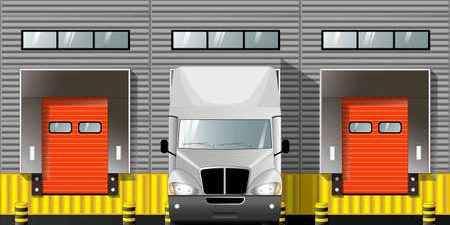In the fast-paced world of industrial operations and increased real estate costs, optimizing efficiency has become paramount for most all of RCR’s industrial clients. Loading docks play a crucial role in the seamless flow of goods, ensuring that materials move in and out of facilities with minimal delays. By selecting the appropriate loading dock style, industrial facilities can streamline their material handling processes, ultimately contributing to overall productivity, safety, and success. Various loading dock styles have evolved over the years, each designed to meet specific operational needs. I have broken down the different loading dock styles commonly found in industrial buildings, exploring their features, advantages, and applications.
Flush Docks:
Efficiency for High Traffic
The flush dock is the most common dock door and is interchangeably referred to as the standard dock. These doors do not protrude from the building and are characterized by their level alignment with the facility floor. Ideal for warehouses and manufacturing facilities aimed to maximize interior space and handle high traffic, flush docks eliminate the need for ramps, ensuring seamless material flow.
Enclosed Docks:
Protection Against the Elements
Enclosed docks provide a shielded environment for loading and unloading operations. Equipped with doors and weather seals, they offer protection against weather elements, enhance security, and enable temperature control. This dock is commonly used in cold storage and food grade facilities as well as pharma grade facilities, many of which can be found in and around the Research Triangle Park that we have located here in Raleigh-Durham.
Sawtooth Docks:
Optimizing Traffic Flow
Sawtooth docks stand out with their angled bays, resembling the teeth of a saw. This helps to save space outside of a facility and this design enhances traffic flow and allows for simultaneous loading and unloading from multiple bays. Facilities dealing with diverse products or fluctuating traffic patterns often find sawtooth docks advantageous.
Depressed Docks:
Seamless Transition for Trucks
Depressed docks, also known as pit docks or declining docks, are set below ground level to facilitate a smooth transition for trucks during loading and unloading. This design minimizes the height difference between the dock and the transport truck, reducing the risk of damage to goods and enhancing overall safety.
Open Docks:
Versatility in Material Handling
Not a particularly common dock, however, open docks offer a versatile and adaptable solution for various material handling needs. They provide an open space without the constraints of enclosed structures, allowing for flexibility in accommodating different types of specialized shipments and handling equipment.
Cross Docks:
Streamlining Distribution Processes
Cross docks serve as distribution hubs where incoming goods are directly transferred to outbound vehicles with minimal storage-in one side and out the other. This design is ideal for high-throughput distribution centers, enabling a rapid and continuous flow of goods, reducing storage costs, and optimizing logistics efficiency.
Questions about dock doors or industrial real estate? Please contact:
Street Jones, SIOR









